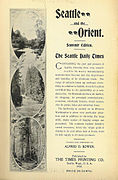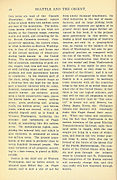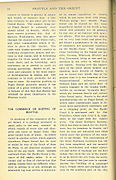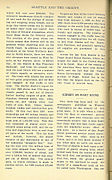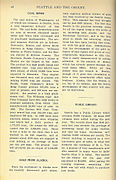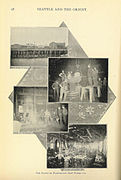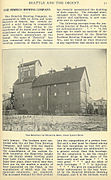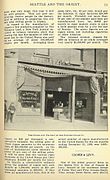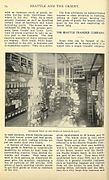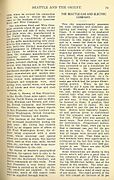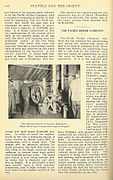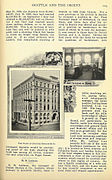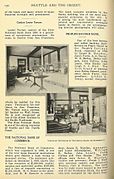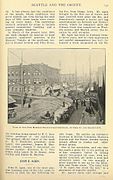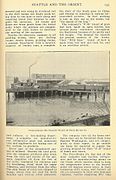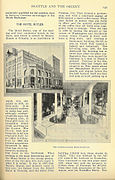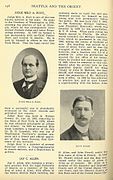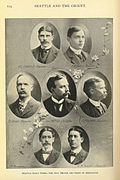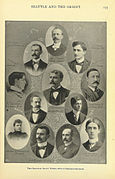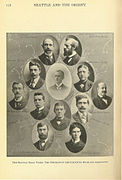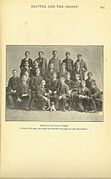Seattle and the Orient

Seattle and the Orient (more properly, Seattle …and the… Orient) was a 1900 "souvenir" pamphlet edited and compiled by Alfred D. Bowen and published by The Times Printing Company (that is, the Seattle Daily Times, now the Seattle Times). It was a promotional document for the city of Seattle. The pamphlet is heavily photo-illustrated, and presents a remarkable (albeit boosterish) textual and visual portrait of Seattle, Washington in the year 1900. (It also includes a set of photo portraits of the Times' own staff from that date.)
Category:Seattle and the Orient includes a complete, readable page-by-page reproduction of the document. The only exceptions are:
- There is only a small image of the front cover
- There is no image of the inside front cover, inside back cover, or the back cover.
The category also contains numerous images extracted from these pages.
Some page images, showing examples of the book's highly varied layout.
Here are some of the many images extracted from the pamphlet:
-
"Colonel" Alden J. Blethen, publisher in 1900 of the Seattle Daily Times.
-
Judge Thomas Burke, one of Seattle's leading citizens of the time.
-
Loggers posing with a 9-foot diameter Douglas Fir.
-
Inside hull of ship under construction in the Moran Bros. shipyard on the Seattle waterfront.
-
The Cedar River, water source for central and south Seattle.
-
In 1900, work crews were digging trenches…
-
…and laying pipe to bring Cedar River water to Seattle.
-
The pipes were manufactured in Seattle at Pacific Bridge Co. This shows the "dipping plant".
-
The exterior of the Terry-Denny Building, which once housed the Northern Hotel, is virtually unchanged today…
-
… but John Collins' nearby Hotel Seattle was demolished in the 1960s, replaced by a parking lot.
-
His Collins Block, across Second Avenue from the Hotel Seattle remains as of 2007…
-
…and the nearby Pioneer Building is now on the National Register of Historic Places, along with an early 20th century totem pole and pergola.
-
Seattle and the Orient proudly displayed Seattle's schools…
-
…including the B.F. Day School, still in use as a school in 2007.
-
The old King County Courthouse stood on First Hill, high above downtown. The climb inspired the nickname "Profanity Hill".
-
In 1900, Seattle's public library resided in the mansion of the late Henry Yesler. The building burned less than a year after Seattle and the Orient was published, and was replaced by a Carnegie library.
Some businesses were covered in considerable depth…
-
The Moran Bros. Co., shipbuilders.
-
Steel ship under construction.
-
The steamer Geo. W. Dickinson under construction. It was eventually purchased by the U.S. Navy…
-
…and renamed the Seward.
-
Bottles for Rainier beer.
-
Washing the bottles…
-
…filling them…
-
…and hand-tinfoiling the filled bottles.
…there are numerous pictures of the mansions of the city's rich and powerful…
-
George Kinnear's home on Queen Anne Hill.
-
Also on Queen Anne Hill, the home of retired army captain W. W. Robinson, Jr.
-
Wilson R. Gay's then-new home on Capitol Hill, which still stands in 2007, but has been divided into condominium apartments.
-
John Collins house on First Hill.
…and a number of other intriguing pictures.
-
Tall ships loading and unloading at the Centennial flour mill.
-
An icemaking chamber at Diamond Ice and Storage.
-
Like most major western U.S. cities of the time, Seattle manufactured gas from coal.
-
The parlor-like office of Butterworth Mortuary.
-
The wall of Meyer & Kassel Gottstein's wholesale liquor and cigar store displayed an ad for "Roosevelt Rough Rider's Rye".
-
The carriage department of Mitchell Lewis & Staver displayed bicycles as well as horse carriages.
-
The composing room of the Denny-Coryell printing company.
-
The Frye-Bruhn meatpacking plant, over a tideflat near what is now Qwest Field (the Seattle Seahawks stadium) advertised "F.B. Co. Brand Hams, Bacon · Kettle Rendered Lead Lard"
Access to all full-page images:
-
2
-
185
-
186
Index on page 184.

















































